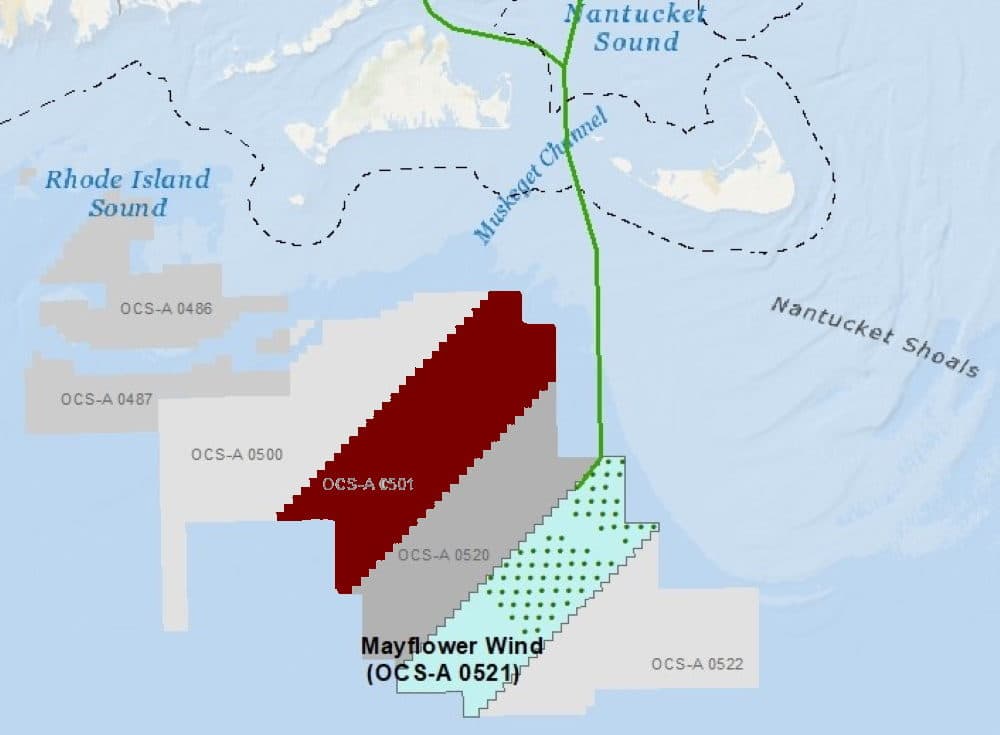Advertisement
Mayflower Wind Picked For 800-Megawatt Project Off Of Nantucket, Martha's Vineyard

An offshore wind development that boasts it will deliver "the lowest cost offshore wind energy ever in the U.S." has been selected by state utilities, in coordination with the Baker administration, to deliver about 800 megawatts of clean power to Massachusetts.
Mayflower Wind, a joint venture of Shell and EDPR Offshore North America, was the unanimous choice of the administration and three utilities to build an array of wind turbines approximately 26 nautical miles south of Martha's Vineyard and 20 nautical miles south of Nantucket, state energy officials announced Wednesday.
The developer submitted four proposed projects for consideration, and the 804-megawatt project that Mayflower Wind calls its "Low Cost Energy" option was selected to move forward and begin contract negotiations.
That project, Mayflower Wind said in its bid document, "is focused on generating the maximum benefits to ratepayers while providing [redacted] over the life of the project for initiatives to support the industry and local economy." It also promises that the project will provide "the lowest price for offshore wind seen in the U.S."
"This was an extremely strong bid, both in terms of competitive pricing as well as in terms of its commitment to economic development," Energy and Environmental Affairs Secretary Kathleen Theoharides said. "On that side, the project is very committed to ongoing funding to initiatives to support the offshore wind industry and local economies of the South Coast and will create significant new jobs in Massachusetts. The company is proposing to adopt a local-first supply chain strategy."
State officials said Wednesday that they could not comment on the project's proposed price because they are now preparing to negotiate contracts. But Department of Energy Resources Commissioner Judith Judson said the administration and distribution companies "were extremely pleased with the pricing we saw as well as the other benefits Mayflower brought into the solicitation."
In the publicly-available version of Mayflower Wind's bid — in which key project details like specific pricing information and the number of turbines envisioned are blacked out — the project developers pledge economic impacts up to "$3.7 billion in electric rate reductions, 10,680 jobs over the life of the project, and direct spending by Mayflower Wind of more than $1.2 billion with virtually all in" economically-distressed areas.
"Mayflower Wind is proud to have been selected to provide low cost renewable energy to Massachusetts," Mayflower Wind President John Hartnett said in a press release that pledged "long term prices below the original price cap of $84.23/MWh."
Advertisement
Hartnett added, "Development of the Mayflower Wind project will contribute to the building of an offshore supply chain on the South Coast and across the Commonwealth, helping to launch a new clean, safe and innovative sector of our economy."
Now that it has been selected as the preferred project, Mayflower Wind must negotiate long-term contracts with the electric distribution companies by Dec. 13. The contracts are expected to be submitted to the Department of Public Utilities for its approval by Jan. 10, 2020. Mayflower Wind said it expects its wind farm to be operational by December 2025.
More details will be made public when DPU begins evaluating the project in January.
In its bid, the Mayflower Wind team committed to locating "our operations and maintenance jobs and base in Massachusetts with at least 75% of O&M jobs being local, with a commitment of $20,000 additional funding per employee shortfall to support further workforce development if required." It also commits to a supply chain strategy that would have the company turn to local providers first.
Judson said the developers also have committed to investing in port infrastructure and upgrades on the South Coast, to backing workforce development grants and industry innovations, and to support marine science research.
The 800 megawatt Mayflower Wind procurement is expected to fulfill the second half of the Legislature's 2016 authorization of 1,600 megawatts of wind power.
Vineyard Wind, which has already had been tapped for the state's first 800 MW procurement, and Bay State Wind, a joint venture between Ãrsted and Eversource, also submitted proposals for the second round of procurement.
The Vineyard Wind I project is currently floating in limbo while the U.S. Bureau of Ocean Energy Management studies the wider impacts of the offshore wind industry to address concerns from fishermen about how Vineyard Wind I's 84 turbines would be arranged. Theoharidies said Wednesday that the state, utilities and wind developers hope to eventually apply lessons from that situation to this newest project.
"The first project, the Vineyard Wind project, certainly was an opportunity for the commonwealth and the entire region to look to lessons learned from that process in terms of working with the federal agencies and what the agencies are looking for through their environmental impact statement process," Theoharides said. "Those lessons will inform the federal permitting discussions here. I think the industry is also working to coordinate more on this as an industry up and down the coast."
If both projects — Vineyard Wind I and Mayflower Wind — come to fruition as expected, the state said they would provide "approximately 12% of total Massachusetts annual energy demand."
Vineyard Wind CEO Lars Pedersen said in a statement Wednesday that Vineyard Wind is disappointed by the decision but "remain[s] fully committed to delivering the first large-scale offshore wind farm in the United States to Massachusetts, and will continue to grow our company in the Commonwealth."
Earlier this year Massachusetts authorized the solicitation of an additional 1,600 megawatts of offshore wind power. Bids for that procurement will go out in two tranches in 2022 and 2024, according to Judson.
WBUR's Bruce Gellerman contributed to this report.
This article was originally published on October 30, 2019.